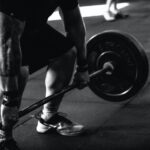
If you’re a fitness enthusiast, you know that achieving a personal record (PR) is a significant milestone in your fitness journey. It’s an accomplishment that represents hard work, perseverance, and dedication to achieving your fitness goals.
This article will discuss personal records, their importance, and how to achieve them.
Table of Contents (click to expand)
Understanding personal records
Personal records measure progress and indicate changes to your weight and how many reps you can perform for a particular exercise. Personal records, also known as PBs (personal bests), aren’t limited to weightlifting or powerlifting.
Still, they can also be achieved in various exercises, such as running, jumping, or any physical activity that can be measured.
Related: How to Start Lifting Weights
You may not yet have a personal record when you start your fitness journey. This is normal and nothing to worry about. You’ll achieve personal records as you progress and become more proficient in a particular exercise.
Achieving a personal record means you have surpassed your previous achievements, motivating you to continue your progress.
Whether you are achieving a record in weightlifting, running, or any other activity, elevating your records is a positive sign of progress in your fitness journey.

The different types of PRs
There are two types of personal records – a gym PR and a competition PR.
Gym PR
This PR is when you achieve a new record in the gym during training or a workout session. This type of PR is a great way to track your progress and measure your success on your fitness journey. You can achieve a new PR for any exercise by lifting more weight or performing more reps than you ever have.
When attempting a new PR in the gym, it’s essential to ensure you’re not sacrificing proper form and technique to achieve the goal. Using bad form and technique to lift more weight can lead to injury, which can significantly derail your progress.
Always prioritize proper form and technique, gradually increasing your weightlifting load.
Related: At what Age Should You Start Lifting Weights
Competition PR
A competition PR is when you achieve a personal record during a competition or sporting event. These events are often more intense and competitive, making them an excellent opportunity to push yourself beyond what you thought was possible. A competition PR can be a great confidence booster and motivate you to continue to push yourself in your fitness journey.
Competition PRs can also be intimidating for some people, especially if it’s their first competition. In these situations, it’s essential to prepare adequately for the event, both physically and mentally.
Training consistently and focusing on the competition goals can help you feel more confident in your abilities to achieve the new personal record.
Why personal records matter
A personal record is an excellent way to track your progress and push yourself beyond your limits. Setting a new personal record often means you have accomplished something you have never done before, which can be a great confidence booster.
Records track personal progression; therefore, seeing progress in the effort, you put in can be incredibly motivational. When you get a new personal best, you will likely feel proud of yourself and more motivated to continue pushing yourself.
With every achievement, you will feel greater confidence in your abilities, making you more likely to stick to your exercise routine over the long term.
Furthermore, achieving a new PR can help you assess your fitness level. If you’re hitting new records regularly, you’re making steady progress, which is great for your overall fitness and well-being.

The importance of a one-rep max
One of the most common ways to measure your new records is through the one-rep max (1RM) test. This test measures how much weight an individual can lift for one repetition of a specific exercise.
The 1RM test is often used as a benchmark for strength training and is commonly used to determine training loads.
Knowing your one-rep max allows you quickly calculate the load you need to lift for different sets and repetitions, making your workouts more efficient and effective. Tracking your one-rep max regularly can also provide insight into your progress and help you identify the areas of your training that need improvement.
Related: What Does Lifting Weights Do?
When testing your one-rep max, it’s essential to do this with the assistance of a professional. Doing so will ensure you follow the proper form and technique for lifting the maximum weight.
Pushing yourself past your limits and attempting a one-rep max can be dangerous if done incorrectly, so always ensure you do it safely.
The most popular lifts to gain a new PR
Setting a personal record, or PR, is a goal many strength trainers and fitness enthusiasts aspire to achieve. While many exercises can help improve overall strength and fitness, specific exercises tend to be more commonly associated with setting personal records.
The “big three” exercises – bench press, squat, and deadlift – are often seen as the basis of a solid strength training program. These exercises simultaneously work for multiple muscle groups and require power and control to perform correctly.
With consistent practice, progression in weightlifting, and careful attention to form, many athletes can achieve significant strength gains and set new personal records in these exercises.
However, it’s important to note that the exercises you focus on should be tailored to your goals and abilities. Some people may respond better to other exercises or training methods, such as bodyweight exercises, kettlebell workouts, or circuit training.
Related: When Can Kids Start Lifting Weights: A Comprehensive Guide
Additionally, factors like age, fitness level, injuries, and personal preferences can all play a role in determining which exercises are most effective for you. For many, it’s about hitting PR on the bench press. For others, it’s all about smashing your one-rep deadlift PR.
Ultimately, the key to setting a personal record in any exercise is to focus on consistent, progressive overload over time. This means gradually increasing weight, reps, or sets as your body adapts your central nervous system and triggers new muscle growth.
With patience, dedication, and a willingness to listen to your body and adjust your training, you can achieve excellent results and reach new heights in your fitness journey.

Best practices for nailing a new PR
As an athlete or fitness enthusiast, achieving a new record (PR) can be exciting. For those looking to improve their squat PR, focusing on a specific exercise and gradually progressing from body-weight squats to heavier weights is key.
Building strength and perfecting form over time make maxing out at a new PR attainable.
Choosing the proper exercise is essential when aiming for a new rep PR or maximum reps at the same weight. By selecting an exercise that works the specific muscle groups you want to target and focusing on perfecting your technique, you build up muscle memory and improve your overall performance.
Challenging yourself is important, but increasing reps or weight too quickly can lead to injury. It’s better to gradually and intentionally increase your heaviest weight or previous maximum reps to avoid setbacks.
To ensure continued progress, incorporating variety in your workout routine helps keep things interesting while encouraging development. Trying new exercises or techniques offers fresh insight and a change of pace from the usual routine.
By staying disciplined and consistent in your training and focusing on the best exercises and techniques, you can quickly achieve your goals and celebrate new PRs.
Related: How to Take Measurements for Weight Loss
Tracking your personal records
PR tracking can be done in various ways, including fitness apps, tracking sheets, or a training journal. Keeping a record of your PR attempts and rep ranges can help you see how far you’ve come by tracking progress over time.
Using a fitness app like MyFitnessPal or Fitbit allows you to track metrics like weight, reps, and sets over time, making it easy to see your progress and set new goals.
Tracking can also be done on paper – simply jotting down your previous maximum reps, sets, or heaviest weight, including the date completed, can be an easy way to keep track of your progress.
A training journal can be especially helpful for those who enjoy writing things down. By documenting your reps, sets, and weight during each training session, you can identify patterns and trends, both good and bad, and track overall progress over time.
A training journal can also provide valuable insights into how your body responds to different exercises, allowing you to fine-tune your workouts and tailor them to your needs.
No matter how you track your records, maintaining it can help you stay motivated and hold yourself accountable for your fitness goals.
By reflecting on your progress and celebrating your achievements, you’ll be inspired to push yourself further and achieve even greater success in your training.





































